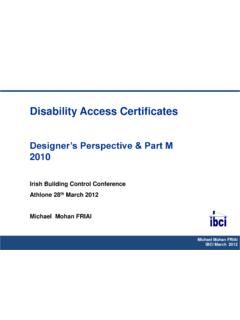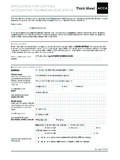Transcription of A guide to the latest revision of the Building Regulations ...
1 BackgroundThe basis for the current Building Regulation standards date back to the early 1950's when 225mmthick solid brick walls and concrete floors where the norm and provided reasonable resistance to thepassage of then Building practices have changed dramatically. For some time now,the deemed-to-satisfy list of constructions that accompanied the guidance notes in ApprovedDocument E has not always achieve satisfactory standards of sound insulation in addition, there has been a considerable changes in lifestyle resulting in increased noise common ownership of home entertainment systems is but one graphic example of this home working, the trend towards working unsociable hours and rising expectations has meantpeople are less tolerant of noise disturbance. As a direct result, the number of noise relatedcomplaints has more than trebled during the last DatesThe latest revisions to Part E of the Building Regulations came into effect on 1st July 2003and has been designed to address the issues highlighted testing for compliance with the Regulations will be obligatory for all buildingconversions from 1st July testing for compliance with the Regulations will be obligatory for all new buildingsfrom 1st January 2004, unless special exemption is granted for Robust Standard Details (RSDs).
2 Summary of the Main Changes A new rating method: DnT,w + Ctr will come into effect on 1st July 2003. The primary purpose of the Ctr factor is to improve the sound insulating performance requirements of the structure at low frequencies. Builders can build whatever they like but they MUST PROVE to the satisfaction of the Building Control Officer that the construction meets the requirements of the Building Regulations . This effectively means a proportion of all new and conversion work will be subject to MANDATORY testing. The emphasis throughout the new guidance is on the control of FLANKING noise, the noise that reaches the receiving room from the source room but not directly through the specific floor or wall. The new guidance includes much advice on what to 'DO' and what 'NOT TO DO'. There is considerable emphasis on the avoidance of bridging between Building elements.
3 Where constructions derive a part of their performance from ISOLATION, this must be Performance Requirements* Applied to floor constructions onlyA guide to the latest revision of the Building Regulations ApprovedDocument E- Resistance to the passage of soundEffective from 1st July 2003 Party Walls,Floors & StairsAirborne NoisePre July 2003 Post July 2003 DnTw dB DnTw + Ctr dBImpact NoisePre July 2003 Post July 2003 LnTw dB LnTw dBNew Build52456162 Conversion484365641/4 Trim Acoustics Tel: 020-8443-0099 AffectedWalls and floors in every residential conversion, new build and extension project will be affected bythe changes. This includes hotels, student accommodation and all other specialist only exceptions being refurbishment projects in residential buildings of historic significance,where there will be a 'test and declare' option if the new standards cannot be in the Detail of the Revised RegulationsIt is not practical here to detail all the constructions.
4 This section simply highlights some of the moreobvious changes, which affect common Building constructions used in high-density build,* Each wall and floor type is described and then the associated flanking details are provided for each case.* In order to 'comply' with the 'approved constructions', you MUST also comply with ALL OF THE DETAILING.* Some construction methods are now incompatible, cavity party walls and continuous solid floors.* Beam and block floors are no longer 'approved' for use as party floors. The advice is to 'seek guidance from `the manufacturer'.* For new build, all block work party walls are to be wet plastered. Dry lining finishes are to be referred to 'the manufacturer'. * For vertically adjacent flats, the weight of the inner leaf of the external wall is to exceed 120kg/m2. In practical terms this would appear to exclude lightweight concrete blocks (Some exceptions are given)* For floating floors, there is a maximum dynamic stiffness of 15 MN/m3 and minimum resilient layer thickness of 5mmRequirements for TestingIn summary, testing should be carried out on site as part of the construction process, and ApprovedDocument E refers to this as 'pre-completion testing'.
5 The person carrying out the Building work is responsible for ensuring that appropriate sound insulationtesting is undertaken and they are also responsible for the cost of the Control Bodies are responsible for selecting both the properties to be tested, and the numberto be performance standards to be achieved have a built-in allowance for measurement uncertainty, soif any test shows one of the values has not been met, the structure will Should he Tested and WhenTests are to be carried out between rooms or spaces that share a common area of separating wall orseparating are to be carried out once the dwelling-houses, flats or rooms on either side of a separating element areessentially complete. Impact sound insulation tests should be carried out before carpets, foam backed vinyl etc arelaid on floors. There are some exceptions on floor coverings, which are detailed in the is no need to test between living spaces, corridors, stairwells or Acoustics Tel: 020-8443-0099 of Constructions to be TestedTest results only apply to the particular constructions tested and will be considered indicative of theperformance of others of the same type in the same development.
6 It is therefore essential that developments be splitinto a number of notional (including bungalows), flats and rooms for residential purposes are considered asthree separate groups. If significant differences in construction types occur within any of these groups, then sub-grouping by type of separating floor and separating wall should be establishedFurther sub-grouping may be required if there are differences between flanking details at wall and floor junctions,different cavities or if the construction is considered to have unfavorable features such as large potential flankingareas, for example unbroken walls in a control bodies can exercise their judgment to determine Number of Tests RequiredBuilding Control Bodies should consult with developers on likely completion times on site, and askfor one set of tests to be carried out between the first dwelling-houses, flats or rooms for residentialpurposes scheduled for completion and/or sale in each group or sub-group.
7 This applies regardless ofthe intended size of the group or sub-group. Therefore if a site comprises only one pair of dwelling-houses, flats or rooms for residential purposes, they should be further properties on the same development become ready for testing, Building control bodiesshould indicate at what point(s) they wish any further set(s) of tests to be conducted. Assuming no testsare failed, Building control bodies should stipulate at least one set of tests for every ten dwelling-houses, flats or rooms for residential purposes in a group or should be conducted more frequently at the beginning of a series of completions than towardsthe end, to allow any potential problems to be addressed at an early stage. However, on largedevelopments testing should be carried out over a substantial part of the construction Following a Failed Set of TestsIn the event of a failed set of tests, appropriate remedial treatment should be applied to the rooms thatfailed the test.
8 A failed set of tests raises questions over the sound insulation between other roomssharing the same separating element in the dwelling-houses, flats or rooms for residential purposes inwhich the tests were conducted. The developer should demonstrate to the Building control body'ssatisfaction that these rooms meet the performance standards. Normally this would be done by (a)additional testing, and/or (b) applying the appropriate remedial treatment to the other rooms and/or (c)demonstrating that the cause of failure does not occur in other failed set of tests raises questions over properties between which tests have not been carried out. Thedeveloper should demonstrate to the Building control body's satisfaction that such properties meet theperformance standards. Once a dwelling-house, flat or room for residential purposes is occupied, anyaction affecting it should be a matter for local a failed set of tests, the rate of testing should be increased until the Building control body issatisfied that the problem has been of TestingWhere pairs of rooms on either side of the separating element are different a bedroom and a studyor a living room and a bedroom, at least one of the rooms in one of the pairs should be a bedroom andat least one of the rooms in the other pair should be a living the layout has only one pair of rooms on opposite sides of the entire area of separating wall orfloor between two dwelling-houses, flats or rooms for residential purposes then the number of airborneand impact sound insulation tests may be reduced Acoustics Tel.
9 020-8443-0099 of Rooms to be TestedThe table below shows the minimum number of tests required ( Building Control will adviseon the actual numbers for each development). Full details of what tests are to be carried out and inwhich rooms can be found in the of Tests to be UndertakenThere is work ongoing to establish a new set of Robust Standard Details (RSDs). It is not clear atpresent whether constructions to RSDs will also require testing. The aim is to achieve a performanceof+5dB in excess of the new requirements. In so doing, it may be possible that testing for new buildwill then be waived. Testing for conversions will remain mandatory. Under the current wording of thenew part E, no waiver is Additions to the RegulationsThe Performance figures quoted for acoustic products are based on test results and can only be expected if thebuilding design construction has followed good practice to ensure all potential flanking paths have been eliminatedIn order for wall and floor construction to be fully effective, extreme care should be taken to correctly detail thejunctions between the separating wall or floor and associated elements such as external walls and any penetrations.
10 Ifjunctions are incorrectly detailed, the acoustic performance will be limited and Building Regulation requirements maynot be achieved in TypeMinimum numberAirborne Noiseof testsImpact NoiseDwelling House & Bungalows20 Flats with seperating floor but withoutseperating walls22 Flats with seperating floor andseperating walls42 Properties sold beforefitting out2-40-2 Historic BuildingsAs agreed by BuildingControlAs agreed by BuildingControl4/4 Trim Acoustics Tel: 020-8443-0099





